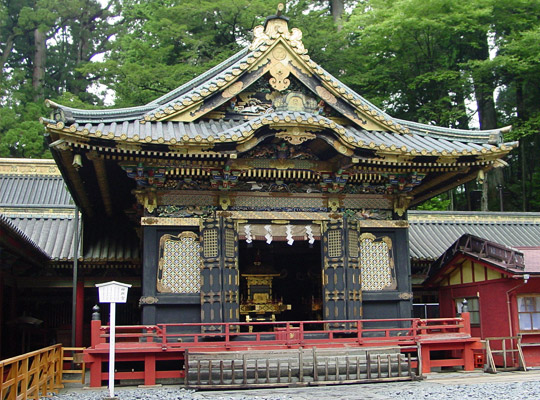|
||
 |
||

Nikkou
Toushouguu Mikoshiyadori 日光東照宮神輿舎 (Tochigi)
(C)2001 Japanese Architecture and Art Net Users System. No reproduction or republication without written permission.
掲載のテキスト・写真・イラストなど、全てのコンテンツの無断複製・転載を禁じます。
|
||||||
| mikoshiyadori 神輿舎 | ||||||
| KEY WORD : architecture / shrines | ||||||
| Also written 神輿宿. Also mikoshigura 神輿倉, or shin'yoko 神輿庫. A storehouse for a portable shrine *mikoshi 神輿. The storehouse protects the shrine when not in use for a festival. The building may also be used as a place to house the deity when the main sanctuary of the shrine *honden 本殿, undergoes repairs. Examples: Tamadeyorimatsuri Kitaru Sakatoke Jinja 自玉手祭来酒解神社 (Kamakura period) in Kyoto. This is the oldest extant storehouse and is referred to as shin'yoko. It is 4.23m wide ×9.09 m long ×2.93m high. It is raised above the foundation so that air can circulate freely beneath the structure. The posts of the framework are square and walls are made of boards laid length wise on the narrow widths, ita-zukuri 板造, and notched so that their ends at the corners extend beyond the wall planes in each direction. The roof is a simple gable type covered with tiles. A good example is Nikkou Toushouguu Mikoshiyadori 日光東照宮神輿舎, Tochigi prefecture. See *otabisho shinden 御旅所神殿, *dashi 山車. | ||||||
 Nikkou
Toushouguu Mikoshiyadori 日光東照宮神輿舎 (Tochigi)
|
||||||
| REFERENCES: | ||||||
| EXTERNAL LINKS: | ||||||
| NOTES: | ||||||
(C)2001 Japanese Architecture and Art Net Users System. No reproduction or republication without written permission. 掲載のテキスト・写真・イラストなど、全てのコンテンツの無断複製・転載を禁じます。 |
||||||